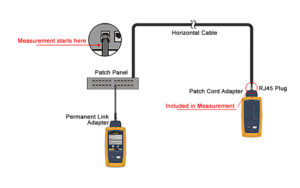A New Acronym To Remember
Filed under: Intelligent Buildings
Comments: Comments Off on A New Acronym To Remember


Our industry is laden with acronyms from AC (alternating current) to ZWP (zero water peak) and everything in between. The newest acronym making its mark on the structured cabling industry is MPTL. It stands for Modular Plug Terminated Link, which refers to terminating the equipment end of horizontal cable with a modular plug to connect directly into a device vs. terminating at an outlet and connecting the device with a patch cord.
You read about it first in our Standards Informant, but you need to know how the MPTL is used and its impact on the structured cabling industry, as it will affect the way we design a network. Channel implementations with an outlet and patch cord are always recommended for equipment connections because they offer more flexibility, support labeling and administration, and eliminate the need to remove long lengths of abandoned cabling should a device be moved. However, sometimes an alternate configuration is necessary, and this new acronym will help advance intelligent building and Siemon’s ConvergeIT initiatives as it provides a new means of connection for the growing number of devices that converge on a unified network infrastructure.
Installing a plug (versus an outlet) on the end of a horizontal cable and plugging directly into an end device is not a new concept, as security camera installers have been doing this since IP cameras came into existence in the late 1990s. The problem is that connecting directly to the device with a plug negates the standards definition of a permanent link, which includes the horizontal cable from the patch panel in the Telecommunications Rooms (TR) to the Equipment Outlet (EO), as well as the definition of a channel, which includes the permanent link and the patch cords on both ends.
Because the MPTL is neither a link or a channel, the main issue is testing and certifying the cable segment? ANSI/BICSI-005 Electronic Safety and Security (ESS) System Design and Implementation Best Practices followed by ANSI/BICSI-007 Information Communication Technology Design and Implementation Practices for Intelligent Buildings and Premises were the first standard documents to accept the MPTL method and referred to it as a “direct connection.” Their solution for testing this cable segment was to override the testing procedure with a “modified permanent link.” However, since BICSI standards are primarily design and installation guides, they defer to TIA to provide direction on cable types including testing methodology, but TIA had not specifically addressed testing this connection method. Until recently.
A Standards-Compliant Approach
In July of this year, TIA published ANSI/TIA-568.2-D in which Annex F addresses the testing and acceptance of the MPTL termination method for certain limited cases when an equipment outlet and patch cord are not practical – typically in environments where the device is not often moved or rearranged. In the MPTL configuration, the horizontal cable is terminated at a patch panel in the TR and the device end would is terminated to a plug and connected directly to the device, or it is terminated to a Service Concentration Point (SCP) outlet, typically housed in a zone enclosure, and from there, the cable is terminated to a plug and connected directly to the device.
 To verify the performance of the final plug connection at the far end, the ANSI/TIA-568.2-D standard also includes a new test procedure that includes the final plug connection . It does this using a permanent link adapter at the TR end and a patch cord adapter at the far end where the cable terminated to the plug. The test figure shows the testing configuration (courtesy of Fluke Networks). It’s important to note that the tester you use must have the proper adapters and software to accurately test this MPTL scenario.
To verify the performance of the final plug connection at the far end, the ANSI/TIA-568.2-D standard also includes a new test procedure that includes the final plug connection . It does this using a permanent link adapter at the TR end and a patch cord adapter at the far end where the cable terminated to the plug. The test figure shows the testing configuration (courtesy of Fluke Networks). It’s important to note that the tester you use must have the proper adapters and software to accurately test this MPTL scenario.
Z-PLUG and the MPTL
The standards’ allowance of the MPTL in certain limited cases and the increasing trend of IP-enabled IB applications is a perfect application for Siemon’s Z-PLUG.

The Z-PLUG is robust, easy to field terminate and can withstand repeatable mating and un-mating of devices. Unlike other plugs, Siemon’s Z-PLUG easily terminates to any category 5e, category 6 or category 6A cable – shielded or unshielded, solid or stranded (22 to 26 AWG) – and it meets UL 2043 plenum requirements.
If your customers are designing intelligent building systems, refer to these standards for proper cabling choices, termination and testing, but make sure you always have a Z-PLUG in your back pocket and be prepared to talk about MPTL.
